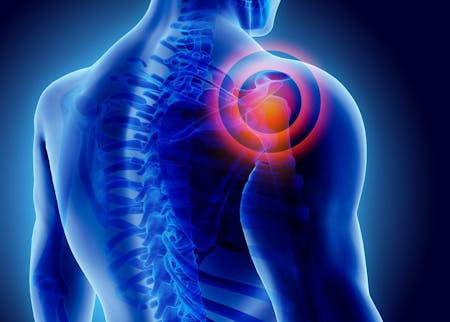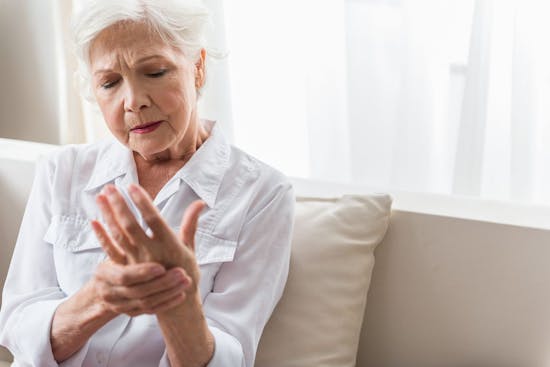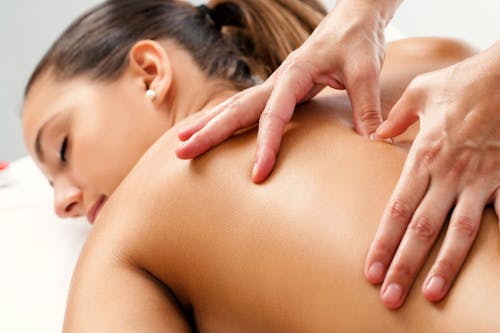-
Are you suffering from joint pain? Get relief now!
Physical therapy works wonders for pain.
Joint pain is discomfort or pain in any part of the body where two or more bones meet to form a joint including cartilage and bone within the joint or ligaments, tendons, muscles and bursae surrounding the joint. It is usually caused by damage resulting from normal wear and tear but can also be caused by an injury and sometimes disease.
Some of the conditions that cause joint pain include:
- Arthritis (Arthralgia) - Osteoarthritis (OA), Rheumatoid Arthritis (RA)
- Muscle Strain - over-stretching or tearing of a muscle
- Tendon Strain - over-stretching or tearing of a tendon (tissue connecting muscle to bone)
- Sprains - over-stretching or tearing of a ligament (band of tissues that connect two bones)
- Fibromyalgia - an autoimmune disorder causing widespread muscle pain and tenderness
- Bursitis - inflammation of the fluid-filled sacs that protect the joint
If you are suffering with any of the above-mentioned signs or symptoms, chances are, our physical therapists can help. Joint pain is a very common condition that we treat on a daily basis. One of the many treatment techniques we use for treating joint pain is called joint mobilization.
What is Joint Mobilization?
Joint mobilization is a manual therapy intervention that involves the application of targeted pressures or forces on a joint accompanied by skilled passive movement of the articular surfaces. This helps relieve joint pain as well as improve mobility and physical function (the ability to walk and move).
Types of Joint Mobilization We use a number of techniques to mobilize (move) joints in the body. These mobilization techniques often have specific names derived from the clinicians that created and successfully tested them on patients.
Examples of some techniques are:
- Instrument Assisted Soft Tissue Mobilization (IASTM)
- Mulligan Manual Therapy - mobilization with movement
- Neural Tension Mobilization – specialized techniques to move nerves
- Graded Mobilizations – low velocity movement techniques with various amplitudes
- Manipulation – high velocity, low amplitude thrust at or near the end-range of joint mobility
Joint Manipulation for the Spine
For people with back pain and stiffness, we use a specific type of mobilization called spinal manipulation (sometimes known as spinal manipulative therapy). This involves using our hands or a device to apply a controlled force to a joint in the spine. The amount of force applied depends on the form of manipulation used. The goal of the treatment is to relieve pain and improve physical functioning.
Side Effects and Risks
Reviews have concluded that spinal manipulation for back pain is relatively safe when performed by a trained and licensed practitioner. The most common side effects are generally minor and include feeling tired or experiencing temporary soreness.
Be sure to tell all of your health care providers about any complementary health treatments you receive. Give them a full picture of what you do to manage your health. This will help ensure coordinated and safe care.
Who can benefit from joint mobilization?
Any patient with joint stiffness or pain can benefit from joint mobilization. However, this technique is generally not used for patients with excessive joint flexibility or fused joints.
-
Have You Been Living with Arthritis? Find the Relief You’ve Been Looking For
Relieve Arthritic Pains with Physical Therapy!
Have you woken up with stiff joints that make it hard to get around in the morning? Even if they may become less painful as the day goes on, you may still be experiencing early-onset arthritis.
Arthritis is a common condition that many people develop; however, many people deal with their painful joints for far too long before seeking professional help.
Fortunately, physical therapy is one treatment option that can be used to treat arthritis pain. One of our licensed Jacksonville, NC physical therapists at Synergy Physical Therapy & Sports Medicine will provide you with gentle exercises to help improve your range of motion, flexibility, and overall function in the affected joint(s).
They can also evaluate which joints are stiff and painful, and assess which exercises will help to relieve the pain of your arthritis during your daily activities.
Treatment doesn't stop there: our therapists will provide you with the resources and knowledge you need to prevent arthritis-related injuries in the future.
If you are suffering from arthritis, or if you think you may have arthritic symptoms, schedule an appointment with Synergy Physical Therapy & Sports Medicine today.
How can a physical therapist help with my arthritis?
Exercise-based recovery through physical therapy helps to restore the typical movement of your joints, improve muscle strength, and improve the way you walk, run, twist, and move.
Physical therapy can even help you avoid the need for surgery and harmful, possibly addicting drugs in many cases. Our treatments are tailored to your specific needs to help you recover quickly and achieve a more permanent outcome. We also teach you ways to prevent future joint injuries, and what you can do with proper therapeutic exercises on your own.
If you are suffering from arthritis, or if you think you might be, you could benefit greatly from our Jacksonville, NC physical therapy services.
Do you have either of these types of arthritis?
According to the Arthritis Foundation, arthritis affects over 50 million people and it is currently the leading cause of disability across the nation.
Arthritis causes pain and inflammation, and it can affect one or multiple joints at once. Osteoarthritis and rheumatoid arthritis are the two most commonly experienced types:
Osteoarthritis
Osteoarthritis is typically easy to diagnose, as it is the most commonly experienced form of arthritis. It occurs when the cartilage of the joint wears down, either due to age or overuse.
This causes pain in the joint, as the cartilage is no longer acting as the thick cushion that it once was. Without a cushion, the bones grind together, which in turn causes an inflammatory response in the joint.
Osteoarthritis can be caused by a sudden injury to the joint, or it can develop after a previous injury has fully healed.
Let’s say you played football and received a rough blow to your knee. You probably received treatment, recovered, and returned to the game thinking all was well again with your body.
Although the injury healed, there is a possibility that the damage that occurred to the cartilage or surrounding muscles has resulted in a decrease of support to the joint. The motion of the joint may also have slightly been altered. Therefore, it is still possible for you to develop osteoarthritis from that injury later in life.
This also applies to those who work jobs that require repetitive motion or cause the overuse of specific body parts. For example, say you are a construction worker. You swing a hammer in repetitive motions as a crucial part of your job, you may develop osteoarthritis in the joints of your elbows or hands.
Being overweight may also put you at a higher risk for developing osteoarthritis, as it adds additional strain to your knee and hip joints.
Rheumatoid arthritis
Researchers have come to believe that a person’s medical history, environment, and hormones could all be contributing factors toward the development of rheumatoid arthritis.
Rheumatoid arthritis develops as an autoimmune response, meaning that the immune system sees the joints as a threat and decides to attack them.
Rheumatoid arthritis is also referred to as “inflammatory arthritis,” and is also fairly common. Because it is an autoimmune condition, it is common for it to affect the same joints on different sides of the body.
This condition is typically more prevalent in females than males as well. Those suffering from arthritis typically report soreness around joints, which is worse after prolonged sitting, standing, or inactivity.
If you have rheumatoid arthritis, you may notice that pain can get worse when you move, for example, bending over at the knees to pick something up may be uncomfortable for you.
You may notice popping or clicking sounds in the affected joint(s) with movement, and the joint may be sensitive or painful to the touch. Arthritis can also cause pain when you exercise or work, and the pain may go away after you stop doing that activity.
Find relief for your arthritic pains today
Arthritis is holding you back. You deserve to enjoy life without suffering from pain.
Contact today to find out how our services can help you find long-lasting pain relief for your arthritis.
We treat all of our patients with the highest level of care, compassion, and understanding. You can rest assured that your symptoms and concerns will be taken into account as your customized treatment plan is designed for you.
Don't let your arthritis limit you any longer - schedule an appointment today.





